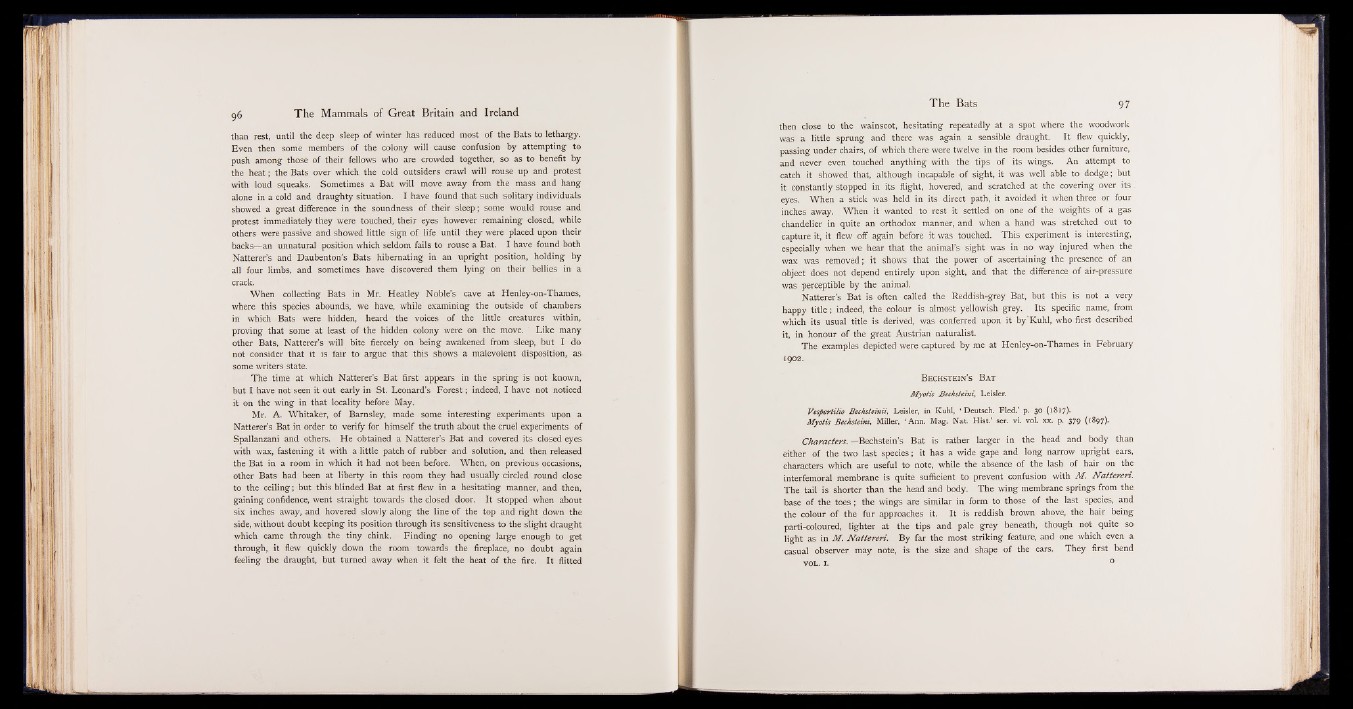
than rest, until thé deep sleep of winter has reduced most of the Bats to lethargy.
Even then some members of the colony will cause confusion by attempting to
push among those of their fellows who are crowded together, so as to benefit by
the heat; the Bats over which, the cold outsiders crawl will rouse up and protest
with loud squeaks. Sometimes a Bat will move away from the mass and hang
alone in a cold and draughty situation. I have found that such solitary individuals
showed a great difference in the soundness of their sleep; some would rouse and
protest immediately they were touched, their eyes however remaining closed, while
others were passive and showed little sign of life until they were placed upon their
backs— an unnatural position which seldom fails to rouse a Bat. I have found both
Natterer’s and Daubenton’s Bats hibernating in an upright position, holding by
all four limbs, and sometimes have discovered them lying on their bellies in a
crack.
When collecting Bats in Mr. Heatley Noble’s cave at Henley-on-Thames,
where this species abounds, we have, while examining the outside of chambers
in which Bats were hidden, heard the voices of the little creatures within,
proving that some at least of the hidden colony were on the move. ' Like many
other Bats, Natterer’s will bite fiercely on being awakened from sleep, but I do
not consider that it is fair to argue that this shows a malevolent disposition, as
some writers state.
The time at which Natterer’s Bat first appears in the spring is not known,
but I have not seen it out early in St. Leonard’s Forest; indeed, I have not noticed
it on the wing in that locality before May.
Mr. A. Whitaker, of Barnsley, made some interesting experiments upon a
Natterer’s Bat in order to verify for himself the truth about the cruel experiments of
Spallanzani and others. He obtained a Natterer’s Bat and covered its closed eyes
with wax, fastening it with a little patch of rubber and solution, and then released
the Bat in a room in which it had not been before. When, on previous occasions,
other Bats had been at liberty in this room they had usually circled round close
to the ceiling; but this blinded Bat at first flew in a hesitating manner, and then,
gaining confidence, went straight towards the closed door. It stopped when about
six inches away, and hovered slowly along the line of the top and right down the
side, without doubt keeping its position through its sensitiveness to the slight draught
which came through the tiny chink. Finding no opening large enough to get
through, it flew quickly down the room towards the fireplace, no doubt again
feeling the draught, but turned away when it felt the heat of the fire. It flitted
The Bats 9 7
then close to the wainscot, hesitating repeatedly at a spot where the woodwork
was a little sprung and there was again a sensible draught. It flew quickly,
passing under chairs, of which there were twelve in the room besides other furniture,
and never even touched anything with the tips of its wings. An attempt to
catch it showed that, although incapable of sight, it was well able to dodge; but
it constantly stopped in its flight, hovered, and scratched at the covering over its
eyes. When a stick was held in its direct path, it avoided it when three or four
inches away. When it wanted to rest it settled on one of the weights of a gas
chandelier in quite an orthodox manner, and when a hand was stretched out to
capture it, it flew off again before it was touched. This experiment is interesting,
especially when we hear that the animal’s sight was in no way injured when the
wax was removed; it shows that the power of ascertaining the presence of an
object does not depend entirely upon sight, and that the difference of air-pressure
was perceptible by the animal.
Natterer’s Bat is often called the Reddish-grey Bat, but this is not a very
happy title; indeed, the colour is almost yellowish grey. Its specific name, from
which its usual title is derived, was conferred upon it by'Kuhl, who first described
it, in honour of the great Austrian naturalist.
The examples depicted were captured by me at Henley-on-Thames in February
1902.
B e c h s t e in ’s B a t
Myotis Bechsteini, Leisler.
Vespertilio Bechsteinii, Leisler, in Kuhl, ‘ Deutsch. Fled.’ p. 30 (1817).
Myotis Bechsteini, Miller, ‘ Ann. Mag. Nat. Hist.’ ser. vi. vol. xx. p. 379 (1897).
Characters. — Bechstein’s Bat is rather larger in the head and body than
either of the two last species; it has a wide gape and long narrow upright ears,
characters which are useful to note, while the absence of the lash of hair on the
interfemoral membrane is quite sufficient to prevent confusion with M. Nattereri.
The tail is shorter than the head and body. The wing membrane springs from the
base of the toes; the wings are similar in form to those of the last species, and
the colour of the fur approaches it. It is reddish brown above, the hair being
parti-coloured, lighter at the tips and pale grey beneath, though not quite so
light as in M. Nattereri. By far the most striking feature, and one which even a
casual observer may note, is the size and shape of the ears. They first bend
VOL. i.